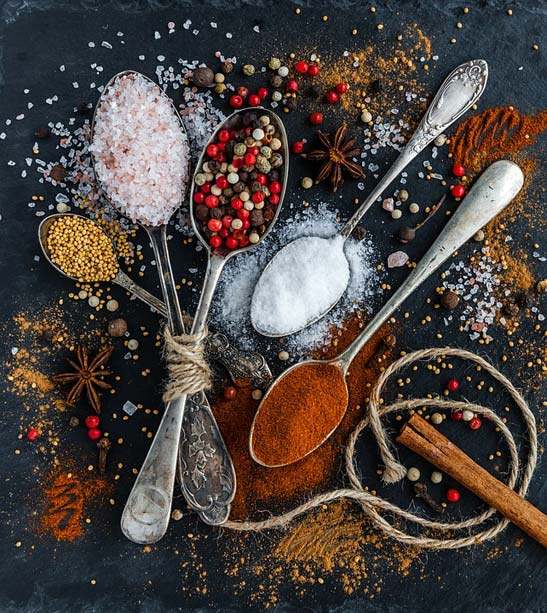
Spices and herbs add delicious variety to the foods we eat. But spices and herbs are much more than flavor enhancers - they are nutritional powerhouses. After all, spices and herbs come from plants, which means they are sources of plant phytonutrients. Many phytonutrients have antioxidant, anti-inflammatory or even anti-cancer properties, and in the case of spices, these phytonutrients can be very concentrated. So spices do more than perk up the flavor of your food - they put a natural pharmacy in your kitchen.
For some Americans, one perceived impediment to cooking with spices is the dislike of spicy food, even though spices are not spicy hot, per se. Spices can make food richly flavorful and aromatic, but they make it hot only if you add fresh, powdered or flaked chile peppers. That heat comes with a few benefits - spicy hot food reduces the need for salt, plus it helps the body sweat and potentially remove toxins.
A handful of spices have enjoyed an elevated status, thanks to their potential to help decrease inflammation in the body: cinnamon, garlic, ginger and turmeric. None of these is a magic bullet, of course, but because they also help make food more flavorful and satisfying, there no reason not to use more of them.
• Cinnamon's versatility lends itself to sweet and savory dishes. Add cinnamon to your breakfast oats, baked goods or meat marinades. Sprinkle it on roasted vegetables or sauteed leafy greens. Mix it into black bean dishes. Some initial studies claim that cinnamon helps to reduce blood glucose and bad cholesterol, but more research is needed.
• Garlic is technically a vegetable, even though few people eat it like one (the French writer Colette is one notable exception). Freshly peeled cloves are best, but you can buy prepacked frozen minced garlic. Garlic appears to benefit cardiovascular health.
• Ginger root is a cornerstone of Asian cooking, imparting a slightly sweet, slightly hot flavor. It goes well with garlic in many Thai, Indian, and Chinese dishes. Ginger can help ease nausea and may also relieve heartburn and bloating. Try a ginger and honey tea when you're under the weather, or add fresh or powdered ginger to smoothies. Fresh ginger root keeps in the fridge for several weeks, longer in the freezer.
• Turmeric is used in Indian and other dishes for flavor, and its intense bright orange color is known to stain kitchenware. Add turmeric to rice or to hot oil before sauteing onions and garlic. Add it to curry dishes, marinades and salad dressings. Recipes for turmeric tea abound online, or you can buy ready-to-go tea bags. When you use turmeric in savory dishes, use black pepper, too, because a compound in black pepper helps your body absorb turmeric's beneficial compounds.
When cooking time is in short supply, spices are an easy way to accentuate simply prepared whole foods such as fish, meat, chicken, vegetables, whole grains and lentils. You can even prepare spice rubs and pastes in advance so they are ready and waiting when it's time to pull a meal together.
One key reason that world cuisines taste different from each other is the distinctiveness offered by the herbs, spices and other aromatic ingredients that are traditional to each one. When you know which flavors are common to your favorite cuisines, you are well on your way to creating tasty dishes without following a recipe. For example, when you are craving Mexican food, you can cook beans and rice, grill some steak, chicken, or fish or bake some tofu, saute peppers and onions, and season to taste with cumin, lime juice, cilantro, salsa and hot sauce if you like it hot.
The spices and herbs you keep in your pantry will depend on your taste preferences, as well as your comfort level with using them. Here are some common ingredient combinations from a few popular cuisines:
• Chinese cuisine includes anise seed, bean paste, chile oil, garlic, ginger, green onions, hot red peppers, sesame oil and seeds, soy sauce and star anise.
• French cuisine includes bay leaves, black pepper, chervil, chives, fines herbs, garlic, marjoram, nutmeg, onions, parsley, pink and green peppercorns, rosemary, shallots, tarragon and thyme.
• Greek cuisine includes cinnamon, dill, garlic, lemon, mint, nutmeg, olives and oregano.
• Indian cuisine anise seed, black and red pepper, cardamom, chiles, cilantro, cinnamon, cloves, coriander, cumin, curry powder, fenugreek, garlic, ginger, mace, mint, mustard seeds, nutmeg, saffron, sesame seeds, turmeric and yogurt.
• Italian cuisine includes anchovies, basil, bay leaves, fennel seeds, garlic, marjoram, onions, oregano, parsley, pine nuts, red pepper and rosemary.
• Spanish cuisine includes almonds, bell pepper, cumin, garlic, olives, onions, paprika, parsley and saffron.


 Contact The Editor
Contact The Editor
 Articles By This Author
Articles By This Author